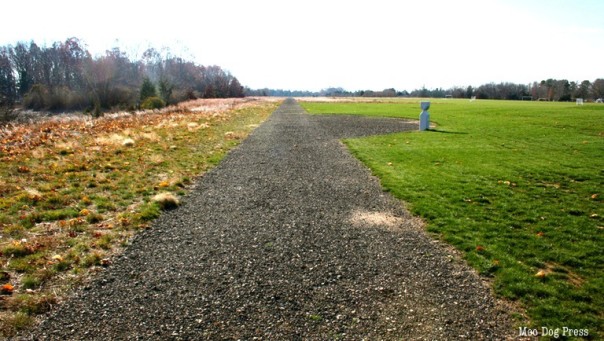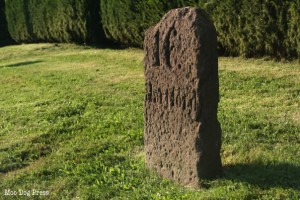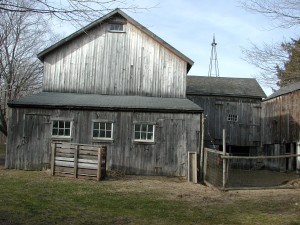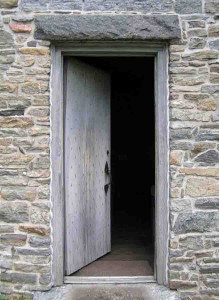Discovery Walks On The Hunt, Old Roads, Aviation At Land Preserves
“From New Haven to Hartford, his way was plain; and from the latter place to Springfield, it was plainer still. At Springfield, he crossed the Connecticut River and turned eastward over the Indian trail from Massachusetts Bay to the valley of the Connecticut, over which the first white men had found their way in 1633. …the Old Bay and the Old Connecticut paths on their way to Springfield, Windsor, Holyoke, Hartford, Wethersfield, and other Connecticut River towns. Two weeks after his departure from New York, he rode through Roxbury into Boston over the narrow neck connecting the mainland with the tri-mountain peninsula, where he delivered his mails and received congratulations on the success of his journey.” – The Old Boston Post Road
Land preserved always has a story behind it.

A 2012 photo of some buildings at the former Griswold Airport. From Abandoned and Little-Known Airports, linked to this image.
Every park, greenway, historical site, and open space took the combined effort of people who stood up to say – no. You can't have this, we just can't lose this place. The sustained hard work to keep a site – large or small – is not for the faint of heart.
So. The season of cold and no leaves is a great time to visit Salt Meadow, a 42-acre park in Madison on the ground the former Griswold Airport. Acquired by the town for $9.5 million ($1.7 million from the Trust for Public Land) in 2010, the flat land with a fringe of wind-blasted trees abuts the tidal Hammonasset River – and more than 1,000 acres of the state-owned Hammonasset Beach State Park.Thoughtfully designed, the graveled pathways echo the landing strips of its previous use as an airport. Spacious playing fields fit easily into the overall acreage, which at one point was proposed to become a housing development. As you enjoy the sweeping views and seemingly endless sky, take the time to acknowledge the foresight and dedication of the people who held fast for this land and river habitat. A canoe/kayak launch and restrooms are planned.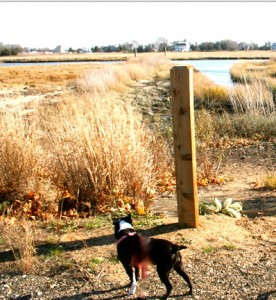
For those who like to inhale salt air and marsh aromas, there's also multiple access points to the amazing Shoreline Greenway Trail, created by an all-volunteer organization dedicated to seeing a 25-mile continuous path for bicyclists, walkers and hikers. Eventually all will connect with parks, schools, town centers, train stations, and trails along the way to Lighthouse Point in New Haven.
On the official site each town has points of interest to look for along the way, such as days gone by when Guilford had trolley service to New Haven and points east. There are interesting facts and lore about local quarries and stoneworkers, geology, little-known history. Should your interest be sparked, stop in to visit a town's library to poke around; a valid library card is all that's needed. (A community's library will tell you much about the town or city in which it is located.)
For instance, the “Old Post Road” was a well-traveled route for riders and teamster drivers who shuttled between New York City and Boston to deliver (what else?) the mail.
But did you know there was an upper, middle and lower Post Road? One was originally known as the Pequot Path, traversed on foot by the people already well established here before any Europeans ever arrived. Some of the original stone milestones still stand as silent witnesses to the days gone by. Try to imagine the journey by foot or on horseback and alternatively with a coach or wagon. Modern-day residents give nary a thought to how roads came into being as they follow or parallel those bygone well-worn pathways. What was the lower Post Road has a storied past that is easy to unearth and fun to follow.
One hardy soul tells great stories (with photos) about the journey in an online journal called “Walking the Post Road.”
Wending along the coastline and not so hidden is the old Boston Post Road with places to check out or visit to warm up.
Should you need an outing with interesting objects – vintage, re-purposed or refreshingly different, don't miss some of the smaller and independently-owned places along the way to or from a destination. Much like beachcombing along the ocean shore (not far away from Route 1), all sorts of interesting objects surface with the tides of time. Each visit is different and so are the things that show up; that's half the fun of a quest. Ask about the original use of a building – some have been around a long, long time.
On another front – The Preserve, which is a 1,000-acre swath of coastal forest located in Old Saybrook, Essex and Westbrook, recently got a boost from Newman's Own Foundation to add to the federal, state, local funds and support by private contributors working together to purchase and preserve the parcel from any development other than trails and outdoor education. Talk about stewardship. With leadership by the Trust for Public Land, the final purchase is expected to completed in spring of 2015.
Should you need an outing with interesting objects – vintage, re-purposed or refreshingly different, don't miss some of the smaller and independently-owned places along the way to or from a destination. Much like beachcombing along the ocean shore (not far away from Route 1), all sorts of interesting objects surface with the tides of time. Each visit is different and so are the things that show up; that's half the fun of a quest. Ask about the original use of a building – some have been around a long, long time.
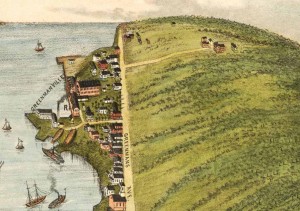
The year was 1879 and that's the Coogan Farm on the right. Image is linked to DPNC and more history of this important land now preserved.
The Coogan Farm at 162 Greenmanville Ave. is on the same street as Mystic Seaport – a treasure hiding in plain view that originated from a 500-acre land grant in the 17th century for service rendered in the Pequot War. There are stone walls, a farmhouse, the site of the original homestead, old foundations, and much more that will come to light since all is now preserved. The Trust for Public Land partnered with the Denison Pequotsepos Nature Center to raise more than $4 million to purchase the 34-acre farm in 2013. The Campaign to Save Coogan Farm received contributions from 760 individuals and businesses, plus grants of $600,000 from the U.S. Fish & Wildlife Service and $500,000 from the state Department of Energy and Environmental Protection. The goal is for the farmhouse to become a center for nature programs and exhibits. Yes, there are a wealth of trails being developed and in the area – here is the link to DPNC for listings and information.
Now, for a fresh point of view of what towns and cities are doing to enhance their communities, consider checking out the comprehensive Recreational Trails Program (RTP) database, which is a repository for national RTP project data usable by policy makers, state administrators, project managers, stakeholders – and the general public.
The U.S. Department of Transportation (DOT) Federal Highway Administration's (FHWA) Recreational Trails Program (RTP) provides funds to states to “develop and maintain recreational trails and trail-related facilities for both non-motorized and motorized recreational trail uses.” Each state then administers its own program, usually through a state resource agency.
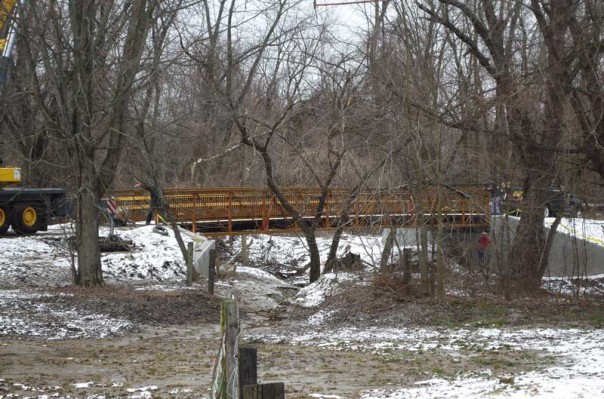
Multi-use bridge on the River Walk in Windsor, a collaboration between the Town of Windsor and CT State Parks Division. The 1.3-mile trail begins at Mechanic Street. Photo: CT State Parks Trails & Greenways Program.
Eligible projects include: Maintenance and restoration of existing trails. Development and rehabilitation of trailside and trailhead facilities and trail linkages. Purchase and lease of trail construction and maintenance equipment. Construction of new trails (with restrictions for new trails on Federal lands). Acquisition of easements or property for trails. Assessment of trail conditions for accessibility and maintenance. Development and dissemination of publications and operation of educational programs to promote safety and environmental protection related to trails (including supporting non-law enforcement trail safety and trail use monitoring patrol programs, and providing trail-related training – limited to 5 percent of a state's funds). State administrative costs related to this program (limited to 7 percent of a state's funds). States are encouraged to enter into contracts and cooperative agreements with qualified youth conservation or service corps.
Database also includes a image library of projects around the U.S. – should you need inspiration of what others are accomplishing in each state.

